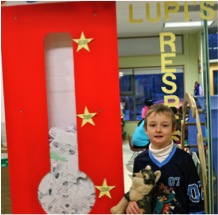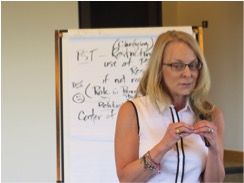National Inclusive Education Month 2016 – Commentary #2
By Liz Baile

I was standing in the school’s primary hallway, watching grade one students walk to the gym, when I noticed Clinton. He was the last student coming out of his class and lagged quite behind the others. As he turned the corner, he looked right at me and said with great joy, “I’m late for gym”. As I watched Clinton with his stuffed husky dog named Mike, and without any adult by his side, I smiled and said, “But you’re getting there!”
Back in my office, I thought back to where we were just a year ago with Clinton. So many challenges faced us as a school, to the point where he could not even go outside for recess without two adults watching him. We felt in crisis, and at a loss for more ideas. Staff were drained, getting confused and frustrated.
A year later, there he was, walking independently with an assistant in the far background (smiling) and Clinton initiating conversation with me. We had turned our “own” corner as a school for this young boy with autism, one of 12 in my school.
 So what made the difference?
So what made the difference?
There were a thousand things, of course, that assisted Clinton in being where he is now. However, one thing I know for sure is that the key ingredients to his inclusion with his peers, and now his academic success, are the collaborative teams and our school’s embedded problem-solving structures and processes.
Problem solving collaboration is the yeast to our school bread. We couldn’t rise and feel productive, if we didn’t have this critical chemistry of skill sets working together in different ways and at different times, with unique synergy.
In my 31 years of being an educator in the Northwest Territories, the power of collaborative teams has been the underpinning to our targeted response to student diversity. Our geographic remoteness has propelled us to create our own sustainable team structures, collegial planning, decision-making and problem-solving processes to the point where they are woven into the fabric of staff timetables and school culture. This has not been an easy journey and at times it has been overwhelming. But we have managed to persist in supporting our students and staff.
 After all, between the frigid temperatures and darkness for weeks at a time, we sometimes live indoors 8 hours at a time. We prioritize time for joint planning and devote specific time and funds for that purpose. Teachers are provided with the opportunity to talk about issues that concern them and come up with a plan for each student that is based on our values and is realistic, respectful, and focused on outcomes.
After all, between the frigid temperatures and darkness for weeks at a time, we sometimes live indoors 8 hours at a time. We prioritize time for joint planning and devote specific time and funds for that purpose. Teachers are provided with the opportunity to talk about issues that concern them and come up with a plan for each student that is based on our values and is realistic, respectful, and focused on outcomes.
Our unspoken motto for our Student Services Team is “Whatever it takes!” – and – for our teachers it is: “Persist, Persist, Persist.” As principal of a diverse, multi-cultural school, I also know if I do not make inclusive educational programming a priority for my students, no one else can. It falls to me, as the school’s instructional leader, to set the course for families, and staff. In Weledeh School we now have eight diverse and embedded staff team structures and five distinct processes for supporting educational programming. I want to share two of the processes with you.
First: Class Mapping with Administration and Programming: This is our newest process to tackle those hard, seemingly unmanageable classroom situations and/or students whose needs are complex. As principal, I invite classroom teachers and my program support teachers to meet in my office in order to “deconstruct” complex classes. I facilitate a “mapping” exercise as the teacher outlines the profile, strengths, needs and challenges of the class.
Together and from the perspective of our different roles, we create a visual landscape of the class. We identify the different ability groupings and decide on priorities. This may include collaboratively determining what processes to abandon. In the end, it is the classroom teacher who decides the proposed strategies for the class and individual learners.
Teachers have appreciated this supportive process. We do follow up sessions each term as needed. I have found my relationship with individual teachers has become richer through this process and it also solidifies our shared goals.
The second of our five processes includes our program support teachers, leadership reliance teachers, and counsellor coming together.
 Second: Student Services Storming: This is a team process for our support teachers, counsellor, community liaison and leadership resiliency teacher. We regularly meet in a tiny room off the staff room to share and review our individual worlds with each other for 80 minutes. Each of us writes the name of the students we are supporting teachers with on the whiteboard. These are students who have been identified as “at-risk” for one reason or another.
Second: Student Services Storming: This is a team process for our support teachers, counsellor, community liaison and leadership resiliency teacher. We regularly meet in a tiny room off the staff room to share and review our individual worlds with each other for 80 minutes. Each of us writes the name of the students we are supporting teachers with on the whiteboard. These are students who have been identified as “at-risk” for one reason or another.
Our discussion is informed by the interactions we have had with the student and teacher in the preceding week. Sometimes we can’t talk about everyone on the list but the approach keeps us focused and we have learned over time how to pace ourselves. The process has helped give us clarity on goal setting. It has also helped us be creative in our responses. As a result we see ourselves as a seamless tag team able to generate supportive collaboration on complex cases. We have tried many different team formats and approaches, but this one seems to work best for us.
If you would like to have an outline of our other school structures and processes, I would be pleased to share these with you as well as our experience in their implementation.
Liz Baile is the Principal of Weledeh Catholic School, Yellowknife, Northwest Territories. She has been a teacher, program support teacher, district inclusion coordinator and assistant principal in Yellowknife Catholic Schools for more than 30 years. She represented the Yellowknife Association for Community Living on the CACL board for several years. Contact Liz at liz.baile@ycs.nt.ca.
